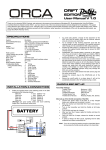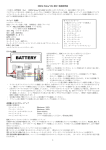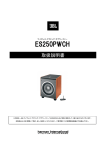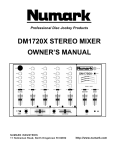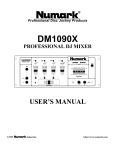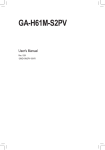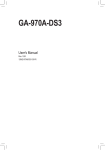Download orca vxx competiton esc user manual
Transcript
NEW VERSION 3.3 Thank you for choosing ORCA Products, and welcome to the power and convenience of Brushless RC. By purchasing the Vritra VXX Competition brushless Electronic Speed Control (“ESC”), you have chosen one of the most advanced speed controls designed for all competition. This speed control with the most linear power curve and our advanced engineering, brings drivers to a new experience of race, allow multiple programmable parameters (using the ESC’s Setting Card be purchased separately). Please read this manual thoroughly to familiarize yourself with the installation, setup, operation, and limitations of this unit. By operating this product, you accept the ORCA Warranty Terms. SPECIFICATIONS System: Brushless Forward/Brake/Reverse: Yes (Factory preset at Forward/Brake) Dimensions: 39(L) x31(W) x 22.5(H) mm Weight: 45g (excluding wires) Voltage Input: (4.8 – 9.9V DC) 3 – 6 Cells NiCD/NiMH 1~2-Cell LiPO / 1-3 Cell LiFe Peak Current 720A Motor Limit: Over 4.5 Turns Motor Type: Sensored 540 sized brushless motors B.E.C.: 6V / 3.0A Multi Protection System: Yes INSTALLATION & CONNECTORS Solder the supplied wires to the soldering posts on the ESC according to the following scheme: Red wire “+” post (Battery +ve) Black wire “-“ post (Battery -ve) Blue wire “A” post (Motor A) Blue wire “B” post (Motor B) Blue wire “C” post (Motor C) Red wire “+” post (Capacitor +ve) Black wire “-“ post (Capacitor –ve) (Warning! Use good quality solder and avoid soldering longer than 5 seconds per solder joint) BATTERY To avoid radio glitches, arrange for the placement of the ESC such that the power wires and the receiver antenna wires do not cross over each other. Try to arrange for the receiver placement such that the receiver plugs are easily accessible. Use supplied extension cable if plugs are not accessible (for ESC setup purposes). Position the ESC where it is protected in the event of a crash; and use the supplied double sided tape to secure the ESC onto the chassis. Install/Solder your favorite battery connector to the battery wires if you do not plan to direct solder your battery. RED to +ve and BLACK to –ve. (Warning! Reversing the battery polarity will destroy your ESC and void the warranty) Connect the 3 motor wires to the motor; you can either solder the wires directly to the motor or use your favorite connectors. Match the label of the wires (A, B, C) to the labels of the taps on the motor when soldering. Avoid soldering longer than 5 seconds per solder joint and avoid shorting the motor by creating a wire bridge or a solder bridge on the solder tabs on the motor. (Warning! Improper wiring may damage the ESC and void the warranty.) Connect the sensor cable between the ESC sensor plug and the motor sensor plug Connect the receiver plug to the CH2/throttle pin of the receiver. Secure the on/off switch in a place where it will not be accidentally knocked to the “off” position during a crash. RADIO & ESC SET-UP Transmitter Settings: Throttle Travel Brake Travel Throttle Exponential Throttle Neutral Trim Throttle Servo Reverse If you do not hear the beeping sound as described above, try reversing the throttle reverse setting in the transmitter. CUSTOMIZING THE ESC Due to the different requirements of each type of racing, it is important to customize your ESC for a particular usage. Customization of the ESC is done using the setting card(purchased separately). To start, simply unplug the ESC receiver wire from the receiver and plug it into the receptacle on the side of the setting card (as shown below), making sure that you plug it in correctly: s (signal) White + (+ve) Red (-ve) Black CH1 CH2 CH3 BAT + RED - BLACK BLUE . A BLUE . B BLUE . C B C LIMITED WARRANTIES / REPAIR PROCEDURES All ORCA products are manufactured according to the highest quality standards. ORCA guarantees this product to be free from defects in materials or workmanship for 60 days from the original date of purchase verified by sales receipt. This limited warranty does not cover damages that are results of normal wear, misuse or improper maintenance of the product. Navigation around the Program Menu is done using the 4 buttons on the right hand side of the setting card. The function of each button varies depending on which screen the display is showing: Team ORCA Ver. XX XXXXXXX: “Enter” button Menu: Program Setup Date Reading : “Enter” button “” button “Enter” button Menu: Advance “Select” button “” button “” button “Enter” button Note! - go to next page - go to “Program Setup” Scroll down the choices go to “Date Reading”. Note! - Scroll down the menu Scroll up the choices Scroll down the choices Copy current display Parameter on the setting card to the ESC and overwrite old data in the ESC To avoid unnecessary service and mailing charges, always eliminate all other possibilities and check all components for malfunctions before sending in your unit for repair. Products sent in for repair that operate perfectly will be charged a service fee. When sending in the product, always pack carefully and include the original sales receipt, a description of the problem encountered, your return address and contact information. Since we do not have control over the installation and use of this product, we cannot accept any liability for any damages resulting from the usage of this product. Therefore, using this product is at your own risk, and the user accepts all resulting liability from installing and using of the product. The setting card is not included the package, need to purchase separately The setting card will compare the Parameters before writing. If no changes are made, the setting card will display “unUpdata”. If changes are made, you will hear a series of beeps and the setting card will display “Send OK”. Tips! Do not worry about making mistakes. You will not damage the ESC during setting. If in doubt, you can always reload the default set up and start over again (Load Menu 13 Default and confirm Send on Menu 15). OPERATING TIPS Multi Protection System – Other than the Low Voltage Protection and the Overheat Protection that were described above, the ESC has 2 more build-in protections: Motor Lock Protection: The ESC is protected against damage when the motor is stuck and does not turn at all. Power will not be applied in this situation. ON OFF A Misc. Tips: Connect the ESC to the battery pack only when you are ready to run. This will avoid draining the battery pack. Always disconnect the battery after your run. A small spark may occur at the connection when the battery is connected. This is normal and is due to the charging up of the capacitors. Tips! Whenever in doubt, double check your ESC setting by initializing the setting card again and check each menu setting. Connect the battery wires to a charged pack of battery. Turn on the ESC and the setting card will activate automatically. Note that the screen will show “Loading…” during initialization – indicating that the ESC is copying the current setup in the ESC to the setting card. Once loading is completed, the screen will show “TEAM ORCA Program” and Current Firmware Version and Data code e.g. Ver3.0 1XXXXXA. You can now start to program your ESC. ROAR Stock Spec Racing: ROAR has announced the new class of Stock Spec Racing using a zero degree timing ESC and 17.5 turn Motor. The Vritra VX Competition ESC satisfies the ROAR requirement showing a blinking LED when set at 0 timing and 0 turbo timing. Menus 1 to 12 are operational settings of the ESC. Each menu consists of its own set of Parameters. Detailed explanation of each menu and its parameter set is found later in this document. It is important that you familiarize yourself with these menu items in order to get the most out of your ESC. Menu 14 allows you to save the current displayed Parameter in the setting card. Maximum of 5 sets of Parameters can be stored. Menu 13 allows you to load either the factory default Parameter or any previously saved Parameters back to the setting card memory. Menu 15 allows you to send the current displayed Parameter on the setting card to the ESC - overwriting whatever is in the ESC. Maximum / 100% Maximum / 100% Start with 0% Center / 0 Reverse (Futaba, KO, Sanwa) Initial set-up of the throttle end-points of the ESC: Connect the power wires of the ESC to a fully charged battery set; making sure the polarity is correct. Bind your receiver and transmitter first if your radio requires you to do so. Turn on the transmitter and hold the throttle at full brake position. Turn on ESC and listen for 2 beeps. After you hear the 2 beeps, apply full throttle and listen for another 2 beeps. Once you hear the 2 beeps, release the throttle to neutral position. A beep will then sound, signifying that the ESC endpoints have been successfully set. Note! Press “Enter” to enter the Program Mode or Date Reading. (Detail please see the OPERATION DIAGRAM in page 2) We have Mod Mode and Stock Mod for each have 15 menus in the Program. Caution! Since the ESC relies on the feed back of the 3 motor wires to deploy this protection, it ONLY works if the motor does not turn AT ALL. If the rotor has any rotation, the ESC will consider the motor to be operational and the power to the motor will not be cut off. Fail Signal Protection: In case the radio signal to the ESC is interrupted for over 1 second during a run, the ESC will cut off until the signal resumes. V I R I TA \ V X X S E R I E S 2. Timing – Allows you to adjust the timing of the motor Caution! Always monitor motor and ESC temperature closely when applying timing to ESC or motor. Heat may build up very fast in both ESC and motor and cost permanent damage to equipment. 3. 5. Turbo Timing – Turbo Timing is unique to brushless Caution! Heat is ESC’s biggest enemy! Monitor your ESC and motor temperature to avoid equipment damage. 6. Turbo Interval – Turbo Interval is effective only when Turbo Timing is in operation. It acts as a “ramp-up” for the Turbo Timing (-6,-5,-4,-3,-2,-1, Normal, +1,+2,+3,+4,+5,+6) Turbo Interval setup is important to ensure high top-end speed on long straightaway. (-6 ~ -1) this will making the turbo more aggressive and early to top speed. (Suitable on high traction) (+1 ~ +6) this will making the turbo more smooth and least to top speed. (suitable on low traction) Default in “Normal” 7. Drag Brake – Also known as trail braking - allows 8. you to set the automatic brake force applied when the throttle returns to neutral position (25 steps from 0% to 25%): Drag brake affects how a car handles off-throttle (entering a corner). With drag brake on, there will be more weight shift to the front tires thus increasing the front end grip when you let go the throttle. Experiment with different settings to find the setting that fits your driving style most. Initial Brake – Allows you to set the amount of brake during manual braking (Steps from OFF to 20%): 12. Save – Allow you to save the setting card display Parameter to the selected memory Parameters in the setting card (5 user defined Parameters): This feature allows you save Parameters for future use. It also allows easy sharing of ESC setup amongst team members. 13. Load – Allows you to load the saved Parameters in the setting card memory to the setting card display menu (6) with user defined Parameters: Loading saved Parameter does not change the ESC setting. It only changes the setting card display Parameter. In order to change the ESC setting, you still need to “Send” the Parameter to the ESC (Menu 14). 14. Send – Allow you to send the setting card display Parameter to the ESC (Yes / No): Yes to confirm or No to cancel sending Note that the original parameter in the ESC will be lost after this operation. 15. Exit – Finish the setting and exit the menu return to previous menu. Program Setup Data Reading enter Advance Setup Basic Setupenter enter enter Modify Mode Stock Mode enter 1.) Running Mode Forward/Brake select 2.) Battery LiPolymer select 3.) Cut off Voltage MIDDLE select 4.) Over Heat 120C select 5.) Neutral Range 7% select 6.) Send Yes 1.) Timing Start 30% Blinky, 5%~40% @5% SETUP RANGE select 2.) Timing 0 Off~20 @1 SETUP RANGE select 3.) Timing Interval -1,-2,-3,Normal,+1,+2.+3 Normal SETUP RANGE select 4.) Turbo Delay 0.02 0.02's~0.15's @0.01.s SETUP RANGE select 5.) Turbo Timing 0 Off~40 @1% SETUP RANGE select 6.) Turbo Interval -1~-6,Normal,+1~+6 Normal s1.) Timing Start 20% s2.) Timing 0 SETUP RANGE select 8.) Initial Brake 3% Off~30% @1% SETUP RANGE 1K, 2K, 4K SETUP RANGE SETUP RANGE select s4.) Turbo Delay 0.02 Level 1~Level 10 @1 SETUP RANGE s5.) Turbo Timing 0 2K, 4K, 8K, 32K SETUP RANGE SETUP RANGE SETUP RANGE s7.) Drag Brake 15% Off~25% @1% SETUP RANGE select S8.) Initial Brake 3% Off~30% @1% SETUP RANGE select S9.) Brake Freq 2K 1K, 2K, 4K SETUP RANGE select S10.) Punch 4 Level 1~Level 10 @1 SETUP RANGE select S11.) PWM 8K 2K, 4K, 8K, 32K SETUP RANGE select S12.) Save Parameter1 select 13.) Load Default Default select S13.) Load Default Default select 14.) Send Yes select S14.) Send Yes select 15.) Exit Yes Off~60 @1% select select 12.) Save Parameter1 SETUP RANGE select select 11.) PWM 8K 0.02's~0.15's @0.01.s select select 10.) Punch 4 SETUP RANGE s3.) Timing Interval -1,-2,-3,Normal,+1,+2.+3 Normal select 9.) Brake Freq 2K Off~40 @1 select select Off~25% @1% SETUP RANGE select S6.) Turbo Interval -1~-6,Normal,+1~+6 Normal SETUP RANGE 7.) Drag Brake 15% Blinky, 5%~40% @5% select S15.) Exit Yes BRAKIN G SYSTE M systems because the ESC can simulate motor timing advance. While mechanical timing advance in brush motor system is limited by the physical phasing of the motor, brushless ESC timing advance can push beyond that physical limit. As a result, motors can run at a super-high RPM in the Turbo Timing mode, resulting in a sensation of having a 2nd gear/Turbo for top speed. This menu allows you to adjust the amount of Turbo Timing in your ESC in 1º increments. (The “Turbo Timing” never bigger than “Timing”.) Turbo Timing is applied at 98% throttle. Higher Turbo Timing settings will increase top speed, but will drive motor and ESC temperatures up as well. 11. PWM – Allows you to change the forward drive frequency of the ESC (2K, 4K, 8K and 64) The 2K setup will give you good punch at the low end. The 32K setup will result in strong mid to top end.(not suggest use in MOD) Experiment to find out what suits your driving style best. Temp enter 105. BRAKIN G SYSTE M Turbo Delay – Allows you to adjust the time gap between the Timing System to Turbo Timing system (From 0.02 sec to 0.15 sec in 0.01 sec increments): Turbo Delay is needed because when the ESC is operating under the Turbo Timing mode, it drives the motor to very high RPM - however, with very low torque. With Turbo Delay, the motor has a chance to rev up before the Turbo Timing kicks in. Thus achieving higher top speed. Proper adjustment of the Turbo Delay will result in smooth transition and continuous power band from regular Timing to Turbo Timing. 10. Punch – Allows you to change the punch of the ESC (Level 1 to Level 10): Level 1 has the least punch and Level 10 has the highest punch. Adjust punch level to maximize acceleration speed with minimum wheel spin. With Mod Mode, start with Level 3 With Stock Mode, start with Level 6 Volt.(Min) 6.8 TURB O TIMIN G SYSTE M “ramp-up” fast and low, than will cause you car pick up more Smooth (+1,+2,+3) or Aggressive (-1,-2,-3) (Default in “Normal”) Rpm(Max) 64000 similar to PWM except it affects the braking instead of the throttle (3 steps 1k, 2k(default), 4k). At 1kHz, the Drag brake and the Brake force will feel the punchiest. At 4 KHz, the Drag brake and the Brake will feel very smooth. TURB O TIMIN G SYSTE M 4. Timing Interval – Allows you to adjust the timing S E R I E S TIMIN G SYSTE M (0~20 for Mod Mode and 0~40 for Stock Mode 1º increments): Generally speaking, in brushless systems, increase in timing will result in increase RPM of the motor. However, increase in timing also decrease the efficiency of the system, thus generating heat on the ESC and motor. Lower timing has the most torque and the lowest RPM; Higher timing has the least torque and the highest RPM. With Mod motor start from Timing 6 With Stock motor start from Timing 15 V X X enter Brake Frequency – Brake Frequency operates TIMIN G SYSTE M Timing Start – Allows you to adjust which throttle point to start to add timing, this will make easy to get a smooth power band for all kind of motors. V I R I TA STOCK MODE 1. 9. Team ORCA Ver3.3 130715b OFF – Brake linear base on transmitter Adjust initial brake to set certain level of “hard brake” effect.(also can adjust your transmitter brake hi-point to get your need the brake force) MODIFY MODE Detailed Explanation of each ESC Menu items: BASIC OPERATION DIAGRAM


